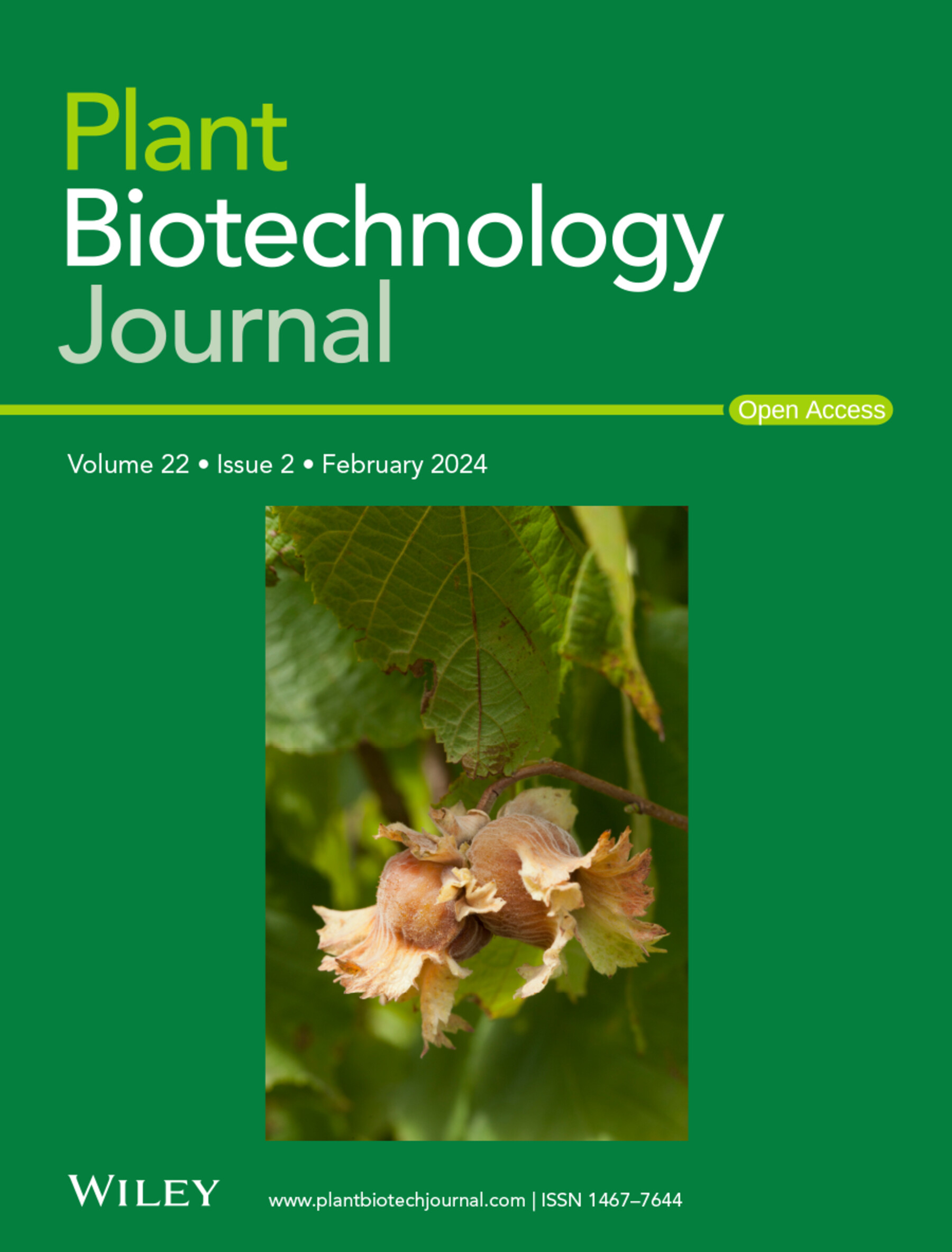玉米三倍体(MTP)--一种新型的玉米矮小突变诱导工具
IF 10.1
1区 生物学
Q1 BIOTECHNOLOGY & APPLIED MICROBIOLOGY
引用次数: 0
摘要
矮小的植株结构有利于密植,增加种植密度可提高玉米产量。然而,矮化材料在玉米育种中的应用目前还很有限。迫切需要消除矮化资源应用的障碍。在此,我们创新了一种新方法,通过玉米-三尖杉-特新特异多倍体(MTP)与玉米的远缘杂交来增加新型玉米矮秆种质。我们发现了十个具有独特特征的独立矮化品系。我们文库中的五个种质受各自矮化基因的控制。但是,没有一个等位基因受 Br2 控制。随后,我们成功地对文库中的 d024 进行了精细测绘,发现它与 ZmCYP90D1 中的 indel-4 有关联。吲哚-4多态性调节 ZmCYP90D1 的表达,并受上游转录因子(ZmBES1/BZR1-5)的控制。ZmCYP90D1 的 indel-4 等位基因会降低植株高度,该等位基因源自玉米野生品种 Tripsacum。然而,d024 表现出对黄铜类固醇(BRs)的敏感性,节间的蓖麻酮含量低于野生型。此外,ZmCYP90D1 与 ZmFDXs 和 ZmNAD(P)H 相互作用,对下游 BR 合成途径起积极调节作用。此外,我们还发现,在高密度条件下,将三叶草等位基因的吲哚-4导入现代杂交种可确保产量潜力并提高收获指数。总之,随着我们开始利用 MTP 制造高度工程化的矮化材料,这种方法将解决玉米矮化所面临的问题。本文章由计算机程序翻译,如有差异,请以英文原文为准。
Maize-Tripsacum-Teosinte allopolyploid (MTP), a novel dwarf mutant inducer tool in maize
Dwarf plant architecture facilitates dense planting, and increased planting densities boost the maize yield. However, breeding applications of dwarfing materials for maize are currently limited. There is an urgent need remove the obstacles to applying dwarf resources. Here, we innovated a new method to add a novel maize dwarf germplasm through the distant hybridization of Maize–Tripsacum–Teosinte allopolyploid (MTP) with maize. We identified ten independent dwarf families with unique characteristics. Five germplasms in our library were controlled by their respective dwarf genes. However, no allele was controlled by Br2. Subsequently, d024 in the library was successfully fine mapped, revealing its linkage to indel-4 in ZmCYP90D1. The indel-4 polymorphism regulates the expression of ZmCYP90D1 and is controlled by an upstream transcription factor (ZmBES1/BZR1-5). The indel-4 of ZmCYP90D1 allele, which reduces plant height, originated from Tripsacum, a wild variety of maize. However, d024 exhibits sensitivity to brassinosteroids (BRs), with lower castasterone levels in the internodes than that in the wild type. Furthermore, ZmCYP90D1 interacted with ZmFDXs and ZmNAD(P)H to positively regulate the downstream BR synthesis pathway. Additionally, we showed that introgressing the indel-4 of the Tripsacum allele into modern hybrids ensures yield potential and improves the harvest index under high-density conditions. Overall, as we begin to manufacture highly engineered dwarf materials using the MTP, this approach will solve the problems faced by corn dwarfs.
求助全文
通过发布文献求助,成功后即可免费获取论文全文。
去求助
来源期刊

Plant Biotechnology Journal
生物-生物工程与应用微生物
CiteScore
20.50
自引率
2.90%
发文量
201
审稿时长
1 months
期刊介绍:
Plant Biotechnology Journal aspires to publish original research and insightful reviews of high impact, authored by prominent researchers in applied plant science. The journal places a special emphasis on molecular plant sciences and their practical applications through plant biotechnology. Our goal is to establish a platform for showcasing significant advances in the field, encompassing curiosity-driven studies with potential applications, strategic research in plant biotechnology, scientific analysis of crucial issues for the beneficial utilization of plant sciences, and assessments of the performance of plant biotechnology products in practical applications.
 求助内容:
求助内容: 应助结果提醒方式:
应助结果提醒方式:


